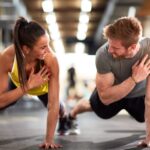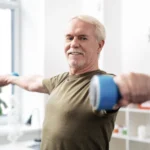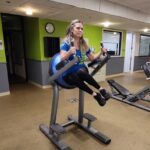Aging is an inevitable process, but that doesn’t mean you have to accept every change it brings, especially when it comes to your physical appearance and strength. Flabby arms, a common concern for those over 60, can be effectively tackled with specific exercises designed to tone and strengthen the muscles in this area.
This guide is dedicated to helping you combat the effects of aging on your arms, providing you with a series of exercises that are both effective and senior-friendly. They are crafted to meet you at your level and help you achieve firmer, more youthful-looking arms.
Top 10 Workouts
- Bicep Curls
- Tricep Dips
- Arm Circles
- Shoulder Press
- Hammer Curls
- Tricep Kickbacks
- Wall Push-Ups
- Side Arm Raises
- Seated Rows
- Overhead Arm Clap
Exercise 1: Bicep Curls
Bicep curls are a classic exercise, well-known for their effectiveness in building arm strength. This exercise is particularly beneficial for seniors as it targets the biceps, a key muscle group in the upper arm, without putting undue strain on the joints.
- Stand with feet hip-width apart, each hand holding a light dumbbell.
- With your palms facing forward, bend your elbows to lift the weights towards your shoulders, engaging your biceps.
- Slowly lower the weights back down, controlling the movement. Repeat this for 10-15 repetitions, focusing on form and control.
Tips
- Keep your elbows close to your sides throughout the exercise to maximize effectiveness.
- Avoid using momentum to lift the weights; focus on using your biceps to power the movement.
- If standing is uncomfortable, this exercise can also be performed while seated, maintaining good posture.
Exercise 2: Tricep Dips
Tricep dips are an excellent exercise for targeting the back of your arms, where flabbiness often accumulates. This exercise can be easily modified to suit various fitness levels and does not require any special equipment.
- Sit on the edge of a sturdy chair with your hands next to your hips.
- Slide your buttocks off the chair, supporting your weight with your arms.
- Bend your elbows to lower your body a few inches, then straighten your arms to lift back up.
- Aim for 8-12 repetitions, focusing on the movement of your triceps.
Tips
- Keep your back close to the chair to avoid unnecessary strain on your shoulders.
- Ensure your movements are controlled to maximize muscle engagement and prevent injury.
- If the exercise feels too challenging, try bending your knees to reduce the load on your arms.
Exercise 3: Arm Circles
Arm circles are a simple yet effective exercise for toning your arms, requiring no equipment and offering the flexibility to be done anywhere. This exercise engages multiple muscle groups in the arms and shoulders, making it a great all-around choice for seniors.
- Stand with your arms extended to the sides at shoulder height, ensuring they are straight.
- Rotate your arms in small circles about the size of a dinner plate, maintaining a steady pace.
- After completing 20 circles, reverse the direction and repeat for another 20 circles.
Tips
- Keep your shoulders down and away from your ears to avoid tension in the neck.
- Start with small circles and gradually increase the size for more intensity, as per your comfort level.
- This exercise can also be done while seated, making it a versatile option for different mobility levels.
Exercise 4: Shoulder Press
The shoulder press is a fantastic exercise for strengthening the upper body, including the arms and shoulders. It’s beneficial for seniors as it helps improve the functional strength necessary for everyday tasks.
- Sit or stand with a dumbbell in each hand, positioned at shoulder height.
- Engage your core and press the weights upwards until your arms are fully extended overhead.
- Carefully lower the dumbbells back to the starting position. Aim to complete 10-12 repetitions.
Tips
- Ensure your movements are steady and controlled to prevent injury.
- If standing, keep a slight bend in your knees to support your back.
- Choose a weight that is challenging yet allows you to complete the set with proper form.
Exercise 5: Hammer Curls
Hammer curls are a variation of the traditional bicep curl, targeting the biceps and forearms. This exercise is particularly good for seniors as it strengthens the arms in a functional grip position, similar to everyday lifting movements.
- Stand with your feet hip-width apart, holding dumbbells with your palms facing in towards your body.
- Curl the weights towards your shoulders, keeping your palms facing each other throughout the movement.
- Slowly lower the weights back to the starting position. Perform 10-15 repetitions.
Tips
- Keep your upper arms stationary, moving only your forearms during the exercise.
- Exhale as you lift the weights, inhaling as you lower them, to maintain a good breathing rhythm.
- Ensure you’re using a weight that allows for control throughout the exercise, without swinging.
Exercise 6: Tricep Kickbacks
Tricep kickbacks are an effective exercise for targeting the triceps, the muscles at the back of the upper arm, which are often neglected.
- Stand with your feet hip-width apart, leaning forward slightly, with a dumbbell in each hand.
- Keep your elbows close to your body, bent at a 90-degree angle.
- Extend your arms backward until they are straight, then return to the bent position.
- Aim for 10-12 repetitions, focusing on the triceps as you extend your arms.
Tips
- Keep your back straight and engage your core to support your posture during the exercise.
- Ensure that only your forearms are moving, while your upper arms remain stationary.
- If bending forward is uncomfortable, this exercise can be done while bent over a chair or bench for support.
Exercise 7: Wall Push-Ups
Wall push-ups are an accessible and effective exercise for seniors, offering a less intense alternative to traditional floor push-ups. This exercise works the chest, shoulders, and arms, helping to build upper body strength.
- Stand facing a wall, an arm’s length away, placing your hands on the wall at shoulder height and shoulder-width apart.
- Bend your elbows to lower your body towards the wall, keeping your feet flat on the ground.
- Push back to the starting position, straightening your arms. Aim for 10-15 repetitions.
Tips
- Keep your body in a straight line from head to heels, engaging your core to maintain proper form.
- To increase difficulty, move your feet further away from the wall.
- Ensure your movements are slow and controlled to maximize muscle engagement.
Exercise 8: Side Arm Raises
Side arm raises are excellent for targeting the deltoid muscles in the shoulders, as well as the upper arms. This exercise is particularly beneficial for improving shoulder mobility and strength.
- Stand with feet hip-width apart, holding a light dumbbell in each hand at your sides.
- Slowly lift your arms to the side, keeping them straight, until they reach shoulder height.
- Lower your arms back to your sides. Repeat for 10-12 repetitions.
Tips
- Keep your movements slow and controlled, avoiding any jerking motions.
- Do not lift your arms above shoulder height to prevent strain.
- If standing for a long period is challenging, this exercise can be performed while seated on a chair.
Exercise 9: Seated Rows
Seated rows are an effective exercise for strengthening the upper back and arms. This exercise is particularly good for seniors as it can help improve posture and reduce back pain.
- Sit on the floor with your legs extended in front of you, securing a resistance band around your feet.
- Grasp the band with both hands, keeping your arms extended.
- Pull the band towards your waist, bending your elbows and squeezing your shoulder blades together.
- Slowly extend your arms back to the starting position. Perform 10-15 repetitions.
Tips
- Keep your back straight and chest up throughout the exercise.
- Focus on using your back muscles to pull the band, not just your arms.
- Adjust the resistance of the band to suit your strength level.
Exercise 10: Overhead Arm Clap
The overhead arm clap is a simple and effective exercise for improving arm mobility and endurance. It’s especially suitable for seniors as it requires no equipment and can be performed either standing or seated.
- Stand or sit with your back straight, arms extended overhead.
- Clap your hands together, then bring them down to shoulder height and clap again.
- Continue this movement for 20-30 seconds, keeping a brisk pace.
Tips
- Keep your movements fluid and continuous to maximize the benefits.
- If standing, ensure you maintain a slight bend in your knees to support balance.
- Adjust the speed of your claps according to your comfort level, increasing as you gain strength.
FAQs
Can I reduce flabby arms solely through exercise, or do I need to make dietary changes as well?
While exercise is crucial for toning and strengthening your arms, dietary changes can complement your fitness efforts. A balanced diet rich in protein, vitamins, and minerals helps in muscle building and skin elasticity.
Reducing excess calories and unhealthy fats can also aid in overall fat reduction, which includes arm fat.
How often should I perform these exercises for the best results?
Ideally, you should aim to perform these exercises 2-3 times per week. Giving your muscles time to rest and recover between sessions is important to avoid overuse injuries and ensure muscle growth.
Is it normal to feel pain in my joints when doing these exercises?
Mild discomfort in muscles is normal as you start a new exercise routine, but joint pain is not. If you experience joint pain, it’s important to modify the exercise to reduce strain or consult a healthcare professional for advice.
Always ensure proper form and start with lighter weights or less resistance.
How long does it typically take to see noticeable results from these arm exercises?
The time it takes to see results can vary based on individual factors like your starting fitness level, frequency of exercise, and diet. Generally, you might start noticing improvements in strength and tone within 4 to 6 weeks of consistent exercise.
Are there any specific stretches I should do before or after these arm exercises?
Yes, stretching is important to prevent injury and improve flexibility. Before your workout, dynamic stretches like arm swings help to warm up the muscles. Post-exercise, static stretches where you hold a position for 20-30 seconds can aid in muscle recovery and flexibility. Examples include triceps stretches and shoulder stretches.
If I have arthritis in my hands or wrists, are there modifications I can make to these exercises?
Yes, if you have arthritis or discomfort in your hands or wrists, you can modify exercises. For instance, use wrist wraps for support, or use resistance bands instead of weights for certain exercises.
Always listen to your body and modify movements to avoid pain, and consult with a healthcare provider or physical therapist for personalized advice.
Summary
Engaging in these 10 exercises regularly can make a significant difference in the tone and strength of your arms, especially if you’re over 60. Consistency is key to seeing results, so integrate these exercises into your routine and practice them regularly.
Be patient with your progress and enjoy the journey towards healthier, stronger arms. It’s never too late to start taking care of your body, and with dedication and perseverance, you’ll see remarkable improvements in both your physical appearance and overall well-being.






